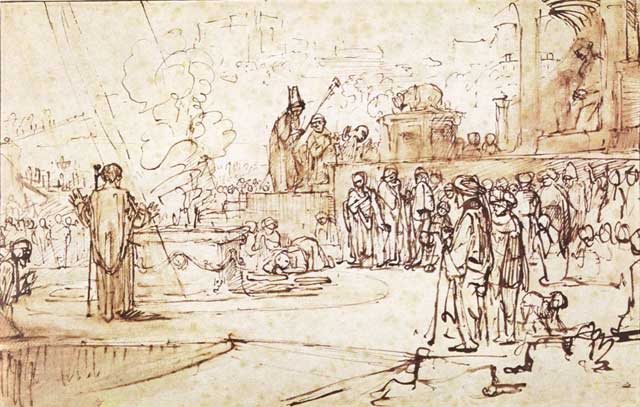When it was time to present the meal offering, the prophet Elijah came forward and said, “O Lord, God of Abraham, Isaac and Israel! Let it be known today that You are God in Israel and that I am Your servant, and that I have done all these things at Your bidding. Answer me, O Lord, answer me, that this people may know that You, O Lord are God; for You have turned theirs hearts backward.” Then fire from the Lord descended and consumed the burnt offering, the wood, the stones, and the earth; and it licked up the water that was in the trench. When they saw this, all the people flung themselves on their faces and cried out, “The Lord alone is God, The Lord alone is God!” (I Kings 18-36-39)
Rembrandt’s sketch of Elijah and the prophets of Baal introduces the viewer to panoply of elements from the biblical story. The figure on the far left is the prophet Elijah who faces the altar that he has reconstructed. His hands reach out as if to spiritually encompass the smoke rising from the offering consumed by the fire of God. Diametrically across from Elijah, on a raised platform, there is an inauspicious figure near another altar. The crown and the royal scepter clue us into his identity- Ahab, King of Israel. Rembrandt’s Ahab is bent over and sheepishly peering at Elijah from under his crown while the prophet stands straight and tall.
All eyes are upon Elijah. He has defeated the prophets of Baal who are congregated on the right of the picture. Although numerous, their dispersion signals their defeat.
It is unclear who is seated in the right top corner. Perhaps Rembrandt has drawn the queen, Jezebel her royal highness; exalted yet alone. On both the right and the left of the altar, Rembrandt has placed figures bowing down and acknowledging that- The Lord alone is God, The Lord alone is God!
Dr. Bryna Jocheved Levy
